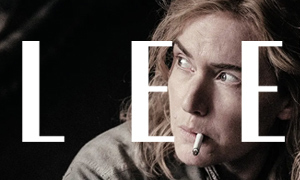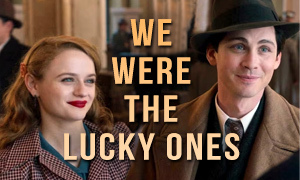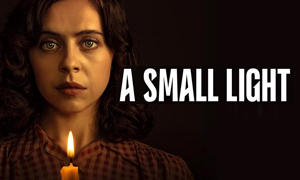A Small Light: History vs. Hollywood
Bel Powley
Born: March 7, 1992
Birthplace:
London, England, UK
Miep Gies
Born: February 15, 1909
Birthplace: Vienna, Austria-Hungary
Death: January 11, 2010, Hoorn, Netherlands
Bio: Otto Frank's Employee who Helped Hide his Family and Others
Joe Cole
Born: November 28, 1988
Birthplace:
Kingston-upon-Thames, London, England, UK
Jan Gies
Born: October 18, 1905
Birthplace: Amsterdam, Netherlands
Death: January 26, 1993, Amsterdam, Netherlands (kidney failure)
Bio: Miep Gies' Husband
Liev Schreiber
Born: October 4, 1967
Birthplace:
San Francisco, California, USA
Otto Frank
Born: May 12, 1889
Birthplace: Frankfurt, Province of Hesse-Nassau, Kingdom of Prussia, German Empire
Death: August 19, 1980, Birsfelden, Switzerland (lung cancer)
Bio: Anne Frank's Father
Billie Boullet
Born: April 5, 2005
Birthplace:
London, England, UK
Anne Frank
Born: June 12, 1929
Birthplace: Frankfurt am Main, Germany
Death: February or March 1945, Bergen-Belsen concentration camp, Germany typhus
Ashley Brooke
Born: 2004
Birthplace:
Los Angeles, California, USA
Margot Frank
Born: February 16, 1926
Birthplace: Frankfurt am Main, Germany
Death: February or March 1945, Bergen-Belsen concentration camp, Germany (typhus)
Bio: Anne's Older Sister
Amira Casar
Born: May 1, 1971
Birthplace:
London, England, UK
Edith Frank
Born: January 16, 1900
Birthplace: Aachen, Prussia, German Empire
Death: January 6, 1945, Auschwitz-Birkenau, German-occupied Poland
How is A Small Light different from other movies and TV series about the Holocaust and Anne Frank's family?
Instead of focusing on Anne Frank and her family, A Small Light takes a different approach. The National Geographic miniseries focuses on Miep Gies and her husband, Jan Gies, who, along with a network of people, helped to hide the Frank family and several other Dutch Jews during World War II. Unlike films such as The Survivor, The Pianist, and numerous others that focus primarily on the victims of the Holocaust, A Small Light is more akin to The Zookeeper's Wife and Schindler's List, which shine a light on the individuals who risked their lives to help the people who were being persecuted.
Did Miep Gies work for Otto Frank, Anne's father?
Yes. For six years, Miep Gies had worked as a typist in an embroidery and pleating workshop before losing her job when the crisis hit. Struggling to find work, an upstairs neighbor told her about another opportunity. The female neighbor worked as a representative for a business owned by a man named Otto Frank. At the time, Otto was still setting up his business, named Opekta, and was looking for employees. Otto's business was located along the canal in the center of Amsterdam at Prinsengracht 263 (pictured below). He had recently moved his family from Germany to the Netherlands in hopes of avoiding persecution. The neighbor arranged for Miep to meet with Otto for an interview. Despite having no experience for the position, her determination, character, and background convinced Otto Frank to take her on as an employee.
As emphasized in the series, the A Small Light true story confirms that Miep was also an immigrant to Amsterdam herself. Her biological family had sent her from Austria to the Netherlands at age 11 as part of a relief project to help malnourished Austrian children. She ended up living with a foster family, the Nieuwenburgs, in the city of Leiden in South Holland. The family moved to Amsterdam in 1924. You can learn more about Miep Gies childhood in her biography Anne Frank Remembered: The Story of the Woman Who Helped to Hide the Frank Family.
What was Otto Frank's business?
The A Small Light fact-check reveals that according to the United States Holocaust Museum, Otto Frank's company, Opekta, "manufactured products used for making jellies and jams." After becoming proficient in the jam-making process, Miep Gies was promoted to customer service, where she took phone calls and responded to questions by mail (AnneFrank.org).
Did Miep Gies have a gay brother?
A Small Light asserts that Miep Gies had a gay brother, Casmir 'Cas' Nieuwenburg, who was unrelated to her by blood. In the series, he is a son of her foster parents in Amsterdam. When she is unable to find a job, due to both laziness and a lack of employment options, her foster parents suggest that she marry her brother, Cas (Laurie Kynaston). Both Cas and Miep are shocked by the idea and we learn that part of the reason is because Cas is a gay man. If you're familiar with Anne Frank's story but never knew about Miep Gies' gay brother, it's because this aspect of the story is entirely fictional.
A Small Light writer Tony Phelan commented on this during an interview with RadioTimes, "And then we took some liberties in the character of Cas, her brother. We know that Miep had five foster brothers – statistically probably one of them was gay," he said. "But deciding to make Cas gay allowed us into the world of the Café 't Manje and the fact that the queer community in the Netherlands was very active in the Dutch resistance."
Had Miep and Jan Gies been recently married?
Yes. Like in the A Small Light miniseries, the true story reveals that Miep and Jan had met at her first job and the two became romantically involved. There is some truth to the marriage starting off as a matter of convenience. Due to the fact that Miep had refused to join the Nazi women's association, her passport was invalidated and she had 90 days to return to her birth country of Austria. Marriage was a way for her to become a Dutch citizen and avoid deportation. Miep and Jan were married on July 16, 1941, approximately one year before they helped the Frank family and others hide during the war. Jan Gies had been working as a social worker for the municipality of Amsterdam at the time. They moved into a house not far from Merwedeplein, the location of Anne Frank's family's home. -AnneFrank.org
Was Miep Gies a short woman?
Yes. Gies stood at just 4 feet 11 inches. British actress Bel Powley, who portrays Gies in the series, is approximately 3 inches taller at 5 foot 2.
Did the Frank family decide to go into hiding when Anne's sister Margot was ordered to report to a labor camp?
Yes. In researching how accurate is A Small Light, we confirmed that on July 5, 1942, Anne's sister, Margot Frank, received orders from the Gestapo to report for the Arbeitseinsatz (labor deployment). The next day, the family made the decision to go into hiding. -AnneFrank.org
Did Otto Frank ask Miep Gies to help hide his family?
Yes. One day, Otto phoned Miep and informed her of the family's plans to go into hiding, asking her if she'd be willing to help them. The A Small Light fact-check confirms that Miep Gies said yes without hesitation. Otto asked three other employees at the office if they'd be willing to help as well, including Victor Kugler, Johannes Kleiman, and Bep Voskuijl. After Margot Frank received orders from the Gestapo to report to a labor camp, Otto put his plan in motion the following day. Miep Gies' husband, Jan, and Bep Voskuijl's father, Johan, were also instrumental in helping. Partially as a result of his contacts at the municipality, Jan was able to secure ration cards. Johan built the swiveling bookcase that concealed the entrance to the secret annex.
"It was a matter of course for me, I was able to help these people," Miep said decades later. "We did our human duty: helping people in need." -Anne Frank Magazine, 1998
Did Miep Gies bicycle with Margot Frank back to her father's company to hide her?
In analyzing the A Small Light fact vs. fiction, we learned that Miep did meet Margot Frank at the family's home at Merwedeplein on the morning of July 6, 1942, the day that the Frank family went into hiding. Margot was not wearing the Star of David on her sleeve and she had an illegal bicycle (by then, Jews were not allowed to use bicycles or public transport). Miep and Margot pretended to be two employees on their way to work. Unlike what's seen in the series, they bicycled in a downpour to the building on the Prinsengracht (the canal in the center of Amsterdam) that housed Margot's father's company. In real life, they didn't encounter any police on the way.
Later in the morning, Margot's father Otto, her mother Edith, and her sister Anne traveled to the building on foot. That day, Miep and her husband Jan brought supplies to the secret annex in the rear of the building where Anne Frank's family went into hiding.
Did the Frank family hide in an annex behind Otto Frank's business?
Yes. Like in the National Geographic A Small Light miniseries, the secret annex was hidden behind a revolving bookcase in Otto Frank's shop, located at Prinsengracht 263 in Amsterdam. For more than two years, the Frank family lived in the annex. Miep Gies recalled being with the Frank family in the secret annex the day they went into hiding.
"The situation was very upsetting. I wanted to leave the family alone together. I couldn't begin to imagine what they must be feeling to have walked away from everything they owned in the world – their home; a lifetime of gathered possessions; Anne's little cat, Moortje. Keepsakes from the past. And friends. They had simply closed the door of their lives and had vanished from Amsterdam. Mrs. Frank's face said it all. Quickly, I left them." -MiepGies.nl
How many people did Miep Gies help hide in the annex?
The A Small Light true story reveals that Miep and her devoted husband Jan helped to hide not just the four members of the Frank family in the secret annex, but also their friends, the van Pels (including Hermann, his wife Auguste, and their 15-year-old son Peter van Pels), and Dr. Fritz Pfeffer, a local dentist. The van Pels arrived a week after the Franks went into hiding and Fritz Pfeffer joined them in November 1942. There were a total of eight people in all. The van Pels resided in the upper floor of the secret annex and the Franks shared the lower floor.
Miep and Jan were two of several people who helped the Franks and the others in the annex. Miep and Bep Voskuijl took on the job of doing the daily grocery shopping. It was Miep's job to bring the meat and vegetables, as well as weekly library books to help pass the time. Bep took care of finding bread and milk. "Miep is just like a pack mule, she fetches and carries so much," Anne Frank wrote in her diary. "Almost every day she manages to get hold of some vegetables for us brings everything in shopping bags on her bicycle."
As the war raged on, less and less food was available to the public. Miep became a hunter, tracking down food on a daily basis for her "ever-hungry nestlings". "But slowly, I was turning into an unrelenting scavenger, and would make do even with scraps," she later recalled. "I could not allow myself to get sick. I could not allow myself a holiday."
Was Jan Gies part of the Dutch Resistance?
Yes. In Miep Gies' memoir, she talks about Jan's job in the Resistance, stating that he would visit people who had gone into hiding after they refused to go as forced laborers to Germany. He would assess the needs of these "illegal people" and then secure various supplies for them, including ration cards and money. Jan had the perfect cover for such work because he was employed as a social worker for the City of Amsterdam.
Jan didn't talk much about his day-to-day activities in the Resistance, and even after the war, he didn't go into much detail. The creators of the National Geographic miniseries have attempted to fill in the gaps with fiction, in part to heighten the tension. The only real truth to what's shown in the series is that we know he was recruited at his job, and because he was a social worker, he had access to many of the apartments in Amsterdam.
Are all of Otto Frank's employees in the series based on real people?
No. Some of the staff are fictional and do not represent real people.
Is Miep Gies' friend Tess based on a real person?
No. Miep Gies' best friend Tess (Eleanor Tomlinson) in the series is not based on a real-life individual. The character was instead inspired by all the people who harbored prejudice and turned a blind eye to what was going on as they attempted to continue living their lives in much the same way as they'd done prior to the German occupation.
Did Miep Gies hide a Dutch student at her house?
Yes. Starting in May 1943, Miep and Jan Gies hid a 23-year-old Dutch student named Kuno van der Horst (pictured below) in their home. He went into hiding after refusing to sign a declaration of loyalty to the Nazis. All university students were required to sign the oath of allegiance, which promised that they would not in any way oppose the occupying forces. Those who objected to signing assumed the risk of being apprehended and sent to Germany. Miep and Jan allowed Kuno van der Horst to stay with them until they felt the risk to their lives was too great. It was then that he returned to his mother and made it through the war. -AnneFrank.org
Where did the title A Small Light come from?
The title was taken from a Miep Gies quote from later in her life. "I don't like being called a hero because no one should ever think you have to be special to help others," she said. "Even an ordinary secretary, housewife, or teenager can turn on a small light in a dark room."
Does the series accurately represent Bep Voskuijl, who also helped Anne Frank's family hide from the Nazis?
Not exactly. In answering the question, "Is A Small Light accurate?" we discovered that the real Bep Voskuijl (pictured below) helped the Frank family in much the same way that Miep Gies does during the course of the series. However, her contributions are somewhat of a footnote in A Small Light. This was likely done to simplify the series, as some of her efforts seem to have been rolled into Miep's storyline. Still, Bep's contributions deserve to be recognized. She too put her life on the line to do what was right. Miep reflected on Bep at the time of Bep's passing, saying, "The special thing about Bep was that she was so humble. She was heroic without bravura, simply assumed that the hiders in the annex must be helped. For her, that wasn't a difficult choice to make." -Collider
Are the Anne Frank House and annex represented accurately in the series?
Yes. Bel Powley told the Jewish Journal that the sets that were built in Prague for the series are "complete replicas" of Otto Frank's business and annex at Prinsengracht 263. "They built it on levels, so ... you could film them walking from the office all the way back into the annex up the stairs. Marc Holmes, our artistic director, is an absolutely incredible man." Holmes was meticulous in his efforts to make every detail of the set as authentic as possible to capture how the home and annex looked during the war. He scrutinized every lightbulb, door knob, and window. Today, the front and back buildings are collectively referred to as the Anne Frank House. In the model below, the secret annex is highlighted in blue.
Did Miep, Anne, and two others fall sick toward the end of 1943?
Yes. While analyzing the A Small Light fact vs. fiction, we learned that next to the fear of being arrested, the hiders and helpers were scared of falling ill. During office hours, the inhabitants of the secret annex had to be extra quiet so as to not alert the stockroom assistants in the office, or anyone else who wasn't aware of their presence. One person's sneezing and coughing could jeopardize everyone in hiding. In November and December 1943, Anne Frank, Miep Gies, Bep Voskuijl, and Johannes Kleiman fell ill. While it caused a good bit of anxiety, fortunately, the sickness wasn't too severe and everyone was feeling better as the year began to wind down. -MiepGies.nl
Were all 8 people in hiding arrested when Dutch police officers raided Prinsengracht 263 and the secret annex?
Yes. All eight people in hiding were arrested when Dutch police officers, commanded by SS-Hauptscharführer Karl Josef Silberbauer, unexpectedly raided the offices and the secret annex on the morning of Friday, August 4, 1944. Two of the helpers, Johannes Kleiman and Victor Kugler, were also arrested. Kugler later noted that "Margot was weeping silently" during the arrest. Miep Gies avoided arrest because she recognized that Silberbauer was speaking with a Viennese accent. "You are of Vienna. I'm of Vienna, too," she said to him. Recognizing their shared heritage as Austrians from Vienna, Karl Silberbauer berated her for helping Jews, but ultimately, he permitted her to remain at the office so long as she promised she wouldn't flee. In this Miep Gies interview, she discusses the raid.
Did Miep Gies go to the Nazi headquarters in Amsterdam and attempt to buy back the Franks' freedom?
Yes. The A Small Light fact-check verifies that in a desperate attempt to free the eight people she had been hiding, as well as two helpers who'd been arrested, Miep Gies put her life at great risk by going to the headquarters of the Sicherheitsdienst in Amsterdam, the intelligence arm of the SS. However, her efforts were ineffective.
The only hopeful sign was that helper Johannes Kleiman was released a few weeks later at the end of September 1944. He was let go as a result of his poor health. Miep, along with the other helpers, kept the business going as they awaited the return of Otto Frank and his family.
Were the Franks sent on the very last train from the Netherlands to Auschwitz?
Yes. Part of what makes the Frank family's story so heartbreaking is that they survived in hiding for more than two years before the annex was raided by Dutch police officers on August 4, 1944. After spending a few days in prison, they were put on a train to the Westerbork transit camp. A few weeks later, they were sent on the very last train to the Auschwitz-Birkenau concentration and extermination camp on September 3, 1944. In fact, they had still been in hiding when the Allies stormed the beaches of Normandy a few months prior in June. World War II in Europe would come to an end in May of the following year with Germany's surrender.
On the night of November 1, 1944, Anne and Margot Frank were loaded onto a train with other prisoners and sent to the overcrowded Bergen-Belsen concentration camp. Anne Frank died at Bergen-Belsen in February or March 1945 from spotted typhus. Her sister Margot passed away a couple of days prior, also from spotted typhus. Just over a month later, the camp was liberated by the British.
Did Miep Gies save Anne Frank's diary after the family's arrest?
Yes. While the Frank family was in hiding, Miep Gies was aware that Anne Frank was keeping a diary. After the raid, Miep Gies went to the secret annex at Prinsengracht 263 to see if she could gather some personal belongings to keep for the Franks. It was then that she found Anne Frank's notebooks and papers lying on the floor. Miep kept Anne's writings in a drawer of her desk, intending to give them back to Anne when she returned. If it were not for Miep Gies, the world would not know the story of Anne Frank.
While exploring the A Small Light true story, we discovered that after it became apparent in mid-July 1945 that Anne Frank had died at the Bergen-Belsen concentration camp, Miep gave Anne's writings to Otto Frank, who had survived and appeared on Miep's doorstep in early June 1945. Otto subsequently lived with Miep and Jan Gies for over seven years. -AnneFrank.org
When did Miep Gies read Anne Frank's diary?
While holding onto Anne's writings in hopes that she would return, Miep did not read them. In fact, when the diary was published in 1947, Miep still hesitated to read it. It was only after the prolonged urging of Anne's father, Otto Frank, that Miep finally gave in and read the book. "I was glad that I had not read the book straight after the arrest, (...) when it was sitting in my desk drawer," said Miep. "If I had, I would have had to burn it, because it was too dangerous for the people Anne wrote about." -Anne Frank Magazine, 1998
In a January 28, 1944 diary entry, Anne Frank expressed her astonishment at the fact that there were so many people willing to assist in saving the lives of others. "The best example of this is our own helpers, who have managed to pull us through so far and will hopefully bring us safely to shore, because otherwise they'll find themselves sharing the fate of those they're trying to protect. Never have they uttered a single word about the burden we must be, never have they complained that we're too much trouble."
Did Miep Gies have any children?
Yes. Miep and Jan Gies had a son named Paul, who was born in 1950, half a decade after the war ended.
How much research did Bel Powley do to prepare for her role as Miep Gies?
Powley said that prior to filming, she traveled to Amsterdam and took a private tour of the actual annex where the Frank family hid. She also traversed the same roads that Miep did during World War II. She told the Jewish Journal, "I did Miep’s bicycle route just to get a feel of it, and I did the cycle ride that she took Margot [Frank] on when she took Margot to the hiding place through the checkpoint."







